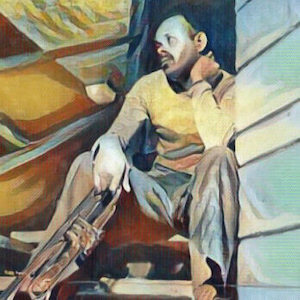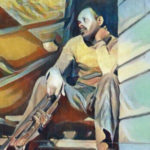

Alphonso Son “Dizzy” Reece is a Jamaican-born trumpeter and composer, celebrated for his distinctive and dynamic trumpet playing characterized by a combination of technical prowess, emotive expression, and improvisational brilliance. Reece’s trumpet style is marked by crisp articulation and his phrasing is often intricate and inventive, weaving melodic lines that reflect a deep understanding of jazz traditions while pushing the boundaries with a modern flair. His playing effortlessly spans a wide range, and he is known for his ability to navigate intricate runs and melodic patterns with finesse.
Born on January 5, 1931, in Kingston, Jamaica, Reece, the son of a silent film pianist, began his musical journey at the Alpha Boys School, renowned for its musical alumni. Transitioning from baritone saxophone to trumpet at the age of 14, Reece became a full-time musician by 16. In 1948, he relocated to London, spending much of the 1950s in Europe, particularly Paris.
Throughout this period, Reece collaborated with notable musicians such as Don Byas, Kenny Clarke, Frank Foster, and Thad Jones. His musical endeavors in London, between 1955 and 1957, included leading sessions and recording his inaugural Blue Note album, Blues in Trinity (1958), featuring sidemen Donald Byrd and Art Taylor. Garnering acclaim from jazz icons like Miles Davis and Sonny Rollins, Reece settled in New York City in 1959. Despite recording with Davis’ bandmates, he encountered challenges navigating the New York jazz scene in the tumultuous 1960s.
Reece’s contributions extend to various Blue Note label records, reissued by Mosaic in 2004. Remaining active as both a musician and writer, Reece collaborated with a diverse array of artists, including Hank Mobley, Wynton Kelly, Paul Chambers, Ronnie Scott, Phil Seaman, Victor Feldman, Tubby Hayes, Paris Reunion Band, Clifford Jordan’s Big Band, Dexter Gordon, Ted Curson, Duke Jordan, John Gilmore, Philly Joe Jones, and Art Taylor.
In addition to his musical pursuits, Reece composed the music for the 1958 Ealing Studios film “Nowhere to Go.” During his tenure with Blue Note records, Reece, like many in their lineup, collaborated with the esteemed engineer Rudy Van Gelder at his Englewood Cliffs studio. This trend continued on his 1962 Prestige album, Asia Minor, where he once again teamed up with legends such as bassist Ron Carter (currently the most recorded jazz musician), renowned saxophonist Cecil Payne, and pianist Hank Jones for the Spring session. The album, thoughtfully recorded and meticulously sequenced, showcases Reece’s fascination with the music of the Asian continent and North African regions. Each composition seamlessly flows into the next. Despite its artistic achievement, Asia Minor marked Reece’s final leadership session until 1967/68.
Following the release of Asia Minor, Reece ventured to Canada for a brief period, where he performed selections from the album. While there, he reportedly made a television appearance in Toronto in the summer of 1963 for “Sixty Minutes With Spoon,” although no online evidence of the recording exists. Collaborating with saxophonists Pepper Adams and John Gilmore during his stay, the latter would later join him on a subsequent album.
Despite his deep admiration for Thelonious Monk’s music, Reece, upon returning to New York, missed the chance to participate in a tribute concert dedicated to the pianist. Scheduled to perform in a big band collaboration with Monk and Hall Overton at Lincoln Centre on November 29th, 1963, the concert was postponed due to the tragic assassination of President John F. Kennedy. Dizzy’s unavailability on the rescheduled date meant Reece, who had composed “Variations on Monk” in homage to the pianist, missed the opportunity to share the stage with him.
This marked a phase of relative public inactivity for Reece. He resurfaced in 1966 with the release of his first instructional book on jazz theory, titled “Contemporary Jazz Drum Suite.” The book, offering an array of rhythmic variations for contemporary percussionists, was the inaugural entry in a series of educational texts authored by Reece, including “Basic Jazz Bass Rhythm And Blues” and others.
In 1967, Reece’s interest in film led to the creation of “The Pressure Cooker By Night,” a thirty-minute film depicting the nighttime streets of Manhattan and Harlem. While this film is not available through online research, sources suggest that Reece’s quartet had previously provided a live soundtrack during performances.
After committing his knowledge of jazz music conventions to text, the unconventional trumpeter returned to the stage in 1968. Joining Dizzy Gillespie’s Reunion Big Band, Reece embarked on a European tour, showcasing his soloing prowess during “Mantega,” the concluding track of a notable 1968 performance in Copenhagen.
Following his collaboration with Dizzy Gillespie and the ensuing album, Reece found a resurgence of past recording sessions. In the same year, he took the lead in sessions for Nirvana, producing original material that remained unreleased until 2006. In March 1969, Reece returned to Copenhagen, this time sharing the stage with saxophonist Dexter Gordon and trombonist Slide Hampton. In an unexpected twist, Reece made a comeback to the Blue Note label in July, contributing to Hank Mobley’s “The Flip,” a recording that featured the legendary drummer Philly Joe Jones. Just a week later, Reece joined forces with Jones again for a live concert recording at Pescara Jazz in Italy. November witnessed over two separate sessions with Rudy Van Gelder, resulting in the recording of material for Andrew Hill’s Passing Ships, which, like the Nirvana sessions, remained unreleased until the 21st century.
In the late sixties, Reece successfully reintegrated into the music scene in New York City. Concurrently, a wave of U.S. jazz musicians sought refuge from the perceived “New York uptightness” by heading to Paris to make innovative recordings with artists from France and North Africa, following the Pan-African Festival in Algiers. Although Reece did not contribute to the BYG Actuel recordings, he did participate in the October 1970 Festival de Créteil. His performance featured drummer Art Taylor, saxophonist John Gilmore (with whom he had played in Canada in ’63), and French musicians Patrice Caratini on bass and Siegfried Kessler on piano. Recordings from this event resulted in “From In To Out,” one of the inaugural releases on the Paris-based Futura Records, preceding recordings by Mal Waldron and Anthony Braxton for the label.
Reece went on to do some recording in Prague with the Slide Hampton & Václav Zahradník Big Band, sessions in the Netherlands with Boy Edgar’s big band, and the creation of another innovative album under his own name, titled Possession, Exorcism, Peace, before 1975. Notably, this album included a reinterpretation of the theme from “The Exorcist,” a component of Mike Oldfield’s renowned composition, “Tubular Bells.”
Between 1977 and ’79, Reece made pivotal contributions to the jazz scene in New York. In April 1977, he participated in Clifford Jordan’s sessions for “Inward Fire” at NYC’s CI recording. Described in the liner notes as a reunion of friends, Reece and Jordan’s relationship is portrayed as that of old friends. Reece notably contributes two compositions to the record, including the stylish closing track, “Eat at Joe’s.”
Moving forward to January 1978, Reece took charge of a session at NYC’s Blue Rock Studio to record “Manhattan Project,” featuring some musicians from Jordan’s “Inward Fire” session, including Jordan himself. Tracks like “Manhattan Walk” and “Yule on the Hudson” pay homage to the region where Dizzy worked and lived, and the album’s imagery conveys a cozy atmosphere. Completing this NYC trilogy was “Blowing Away,” an album recorded in June 1978 with Ted Curson and an exceptional trio.
Between 1977 and ’79, Reece made arguably his most impactful contributions to the history of jazz in New York. In April 1977, he participated in Clifford Jordan’s recording sessions for Inward Fire at NYC’s CI recording. Described in the liner notes as a gathering of old friends, the session captured the camaraderie between Jordan and Reece. Reece notably contributed two compositions to the record, including the smooth closing track, “Eat at Joe’s.”
Continuing this creative streak, in January 1978, Reece orchestrated a session at NYC’s Blue Rock Studio to produce Manhattan Project, featuring musicians from Jordan’s “Inward Fire” sessions, including Jordan himself. Tracks like “Manhattan Walk” and “Yule on the Hudson” paid homage to the region where Dizzy worked and lived. The album’s accompanying imagery conveyed a warm and inviting atmosphere. Culminating the NYC trilogy was Blowing Away, an album recorded in June 1978 with Ted Curson and an exceptional trio.
After a December recording session with Art Matthews, Reece was poised to bestow a jazz gift upon New York City in 1979. In October, the first-ever NYC Jazz Festival, organized by Dizzy Reece, unfolded. Free-entry performances graced Damrosch Park, nestled within Citicorp and the Lincoln Centre. Renowned performers such as Clifford Jordan, Charles Davis, and Tommy Turrentine delighted the audience. Although the festival had a brief existence, its resounding popularity laid the groundwork for subsequent festivals that have taken place since.
Reece’s endeavors over the past 40 years have largely operated beneath the radar, adding an air of mystery and fascination to his artistic legacy. While delving into the realm of challenging solo trumpet works, he has meticulously archived numerous live recordings from the NYC Jazz Festival. Additionally, Reece has engaged in autobiographical writing and has penned various articles, including a substantial biographical history of jazz saxophonists. Notably, he hasn’t rushed to thrust these works into the public eye immediately upon completion.
During these decades, several recordings from his archive have surfaced, although many more remain unaccounted for, as indicated in a 2014 Facebook post. Some live recordings from the eighties have found a platform in Dermot Hussey’s Dizzy Reece radio hour, but accessing his work from that era remains challenging.
A notable documentation of this period is the film “For Klook: The Story of the Paris Reunion Band,” offering a glimpse into the mid-eighties endeavors of a band evoking the vibrant Paris jazz scene of the sixties. The film captures their enduring musical relationships and dedication to the music that had initially captivated them at least thirty years earlier, featuring Reece’s soulful solos on various tracks.
Leave a Reply
You must be logged in to post a comment.